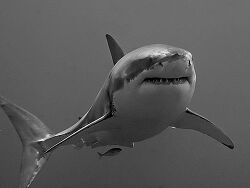Info
(Linnaeus, 1758)
The Great White Shark, Carcharodon carcharias, is the largest known predatory fish in the sea. It reaches lengths of over 6.1 m and weighs up to 2268 kg. It has a conical snout, black eyes, a heavy, torpedo-shaped body and a crescent-shaped, nearly equal-lobed tail fin, which is divided on each side by a keel is. The Great White swims in a more "rigid body", "tuna-like", in contrast to the elegant swimming style of most other sharks.
Just in case you wants to know more about the "Great White Shark" take a look at the below mentioned sites, there is written extensively about him and other sharks.
Synonyms:
Carcharias atwoodi Storer, 1848
Carcharias lamia Rafinesque, 1810
Carcharias maso Morris, 1898
Carcharias rondeletti Bory de Saint-Vincent, 1829
Carcharias verus Cloquet, 1817
Carcharias vorax Owen, 1853
Carcharias vulgaris (Richardson, 1836)
Carcharodon albimors Whitley, 1939
Carcharodon capensis Smith, 1839
Carcharodon rondeletii Müller & Henle, 1839
Carcharodon smithi Bonaparte, 1838
Carcharodon smithii Agassiz, 1838
Squalus carcharias Linnaeus, 1758
Squalus lamia Blainville, 1816
Squalus lamia Blainville, 1825
Squalus vulgaris Richardson, 1836
Classification: Biota > Animalia (Kingdom) > Chordata (Phylum) > Vertebrata (Subphylum) > Gnathostomata (Superclass) > Pisces (Superclass) > Elasmobranchii (Class) > Neoselachii (Subclass) > Selachii (Infraclass) > Galeomorphi (Superorder) > Lamniformes (Order) > Lamnidae (Family) > Carcharodon (Genus)
hma
Shark bites can be quite lethal to humans, especially the 10 most dangerous shark species are considered and can launch unprovoked attacks from humans: - Great white shark - Bull shark - Tiger shark - Sand tiger shark - Blacktip shark - Bronze shark - Spinner shark - Blue shark - Hammerhead shark - Whitetip shark The bite by a shark is one of the most basic fears of humans, but the number of deaths caused by shark attacks is very low: in 2015 there were 98 attacks by sharks and in 6 cases the attack resulted in a fatal end for humans. In 2016 there were 107 attacks by sharks and in 8 cases the attack resulted in a fatal end for humans. Sources: http://hai.ch/Hai-Infos/Unfaelle/index.html http://www.focus.de/reisen/videos/auch-urlaubsorte-betroffen-schrecklicher-rekord-2016-gab-es-mehr-hai-angriffe-als-je-zuvor_id_6519581.html http://www.spiegel.de/wissenschaft/natur/hai-angriffe-erreichen-2015-rekordhoch-weiterer-anstieg-erwartet-a-1076339.html http://www.zeit.de/2016/37/haie-toetung-tierschutz-surfer
In 2022, there were a total of 108 shark attacks in the USA.
Conversely, however, 100 million sharks were killed by humans. http://www.zeit.de/2016/37/haie-toetung-tierschutz-surfer The risk of being bitten by a shark varies greatly from region to region, with most attacks occurring in Florida, Australia and South Africa. Please be careful not to go into the water with bleeding skin wounds, heed bathing warnings from the authorities and be very careful when using surfboards, as sharks can easily confuse the boards with seals and harbour seals. After shark bites, always call a doctor or / and the rescue service as soon as possible, as heavy bleeding can be life-threatening.
https://worldanimalfoundation.org/advocate/shark-attack-statistics/
The Great White Shark, Carcharodon carcharias, is the largest known predatory fish in the sea. It reaches lengths of over 6.1 m and weighs up to 2268 kg. It has a conical snout, black eyes, a heavy, torpedo-shaped body and a crescent-shaped, nearly equal-lobed tail fin, which is divided on each side by a keel is. The Great White swims in a more "rigid body", "tuna-like", in contrast to the elegant swimming style of most other sharks.
Just in case you wants to know more about the "Great White Shark" take a look at the below mentioned sites, there is written extensively about him and other sharks.
Synonyms:
Carcharias atwoodi Storer, 1848
Carcharias lamia Rafinesque, 1810
Carcharias maso Morris, 1898
Carcharias rondeletti Bory de Saint-Vincent, 1829
Carcharias verus Cloquet, 1817
Carcharias vorax Owen, 1853
Carcharias vulgaris (Richardson, 1836)
Carcharodon albimors Whitley, 1939
Carcharodon capensis Smith, 1839
Carcharodon rondeletii Müller & Henle, 1839
Carcharodon smithi Bonaparte, 1838
Carcharodon smithii Agassiz, 1838
Squalus carcharias Linnaeus, 1758
Squalus lamia Blainville, 1816
Squalus lamia Blainville, 1825
Squalus vulgaris Richardson, 1836
Classification: Biota > Animalia (Kingdom) > Chordata (Phylum) > Vertebrata (Subphylum) > Gnathostomata (Superclass) > Pisces (Superclass) > Elasmobranchii (Class) > Neoselachii (Subclass) > Selachii (Infraclass) > Galeomorphi (Superorder) > Lamniformes (Order) > Lamnidae (Family) > Carcharodon (Genus)
hma
Shark bites can be quite lethal to humans, especially the 10 most dangerous shark species are considered and can launch unprovoked attacks from humans: - Great white shark - Bull shark - Tiger shark - Sand tiger shark - Blacktip shark - Bronze shark - Spinner shark - Blue shark - Hammerhead shark - Whitetip shark The bite by a shark is one of the most basic fears of humans, but the number of deaths caused by shark attacks is very low: in 2015 there were 98 attacks by sharks and in 6 cases the attack resulted in a fatal end for humans. In 2016 there were 107 attacks by sharks and in 8 cases the attack resulted in a fatal end for humans. Sources: http://hai.ch/Hai-Infos/Unfaelle/index.html http://www.focus.de/reisen/videos/auch-urlaubsorte-betroffen-schrecklicher-rekord-2016-gab-es-mehr-hai-angriffe-als-je-zuvor_id_6519581.html http://www.spiegel.de/wissenschaft/natur/hai-angriffe-erreichen-2015-rekordhoch-weiterer-anstieg-erwartet-a-1076339.html http://www.zeit.de/2016/37/haie-toetung-tierschutz-surfer
In 2022, there were a total of 108 shark attacks in the USA.
Conversely, however, 100 million sharks were killed by humans. http://www.zeit.de/2016/37/haie-toetung-tierschutz-surfer The risk of being bitten by a shark varies greatly from region to region, with most attacks occurring in Florida, Australia and South Africa. Please be careful not to go into the water with bleeding skin wounds, heed bathing warnings from the authorities and be very careful when using surfboards, as sharks can easily confuse the boards with seals and harbour seals. After shark bites, always call a doctor or / and the rescue service as soon as possible, as heavy bleeding can be life-threatening.
https://worldanimalfoundation.org/advocate/shark-attack-statistics/







 AndiV
AndiV












